
1/3/2017
1
Chapter 5
Industrial Product Strategy
www.dinhtienminh.net
DINH Tien Minh (Ph.D.)
University of Economics HCMC
Objectives
2
Understanding the meaning of an industrial
product.
Know the factors influencing changes in product
strategy.
Learn product life-cycle theory and its
applications.
Understand steps involved in developing product
strategies.
Learn branding in business market.
Content
5.1 Definition of an industrial product
5.2 Changes in product strategy
5.3 Industrial product life-cycle and strategies
3
5.4 Developing product strategies
5.5 Branding in Business Market

1/3/2017
2
4
5.1. Definition of an industrial product
Definition: The industrial product in defined
not only as a physical entity, but also as a
complex set of economic, technical, legal and
personal relationship between the buyer and
the seller.
Nguồn: Webster F.E., Jr., Industrial Marketing Strategy, John Wiley & Sons,
2nd edition, p.106.
5
5.1. Definition of an industrial product
Example of an industrial product
Product: Moulded Case Circuit Breakers.
Economical side: Price
Technical side: Specifications
Legal side: If the supplier delays delivery.
Personal relationships between itself and the
suppliers.
6
5.1. Definition of an industrial product
From the customer’s point of view, a
product is a combination of :
Basic properties are included in generic product
made differentiable by adding tangible benefits.
Enhanced properties such as product features,
styling and quality.
Augmented properties such as spare parts,
maintenance, repair service, warranties…
Nguồn: Krishna K Havaldar (2010), Business Marketing, McGraw Hill,
3rd edition, p42

1/3/2017
3
7
5.1. Definition of an industrial product
Technical assistance
Spare
Parts
Maintenance
Timely
Delivery
Payment term
Augmented
Product
Enhanced
Product
Generic
Product
Features
Styling Quality
Fundamental
Benefits
8
5.1. Definition of an industrial product
An industrial marketer should be aware of what
constitutes a total product package in the
mind of prospective customers
(Tangible and Intangible Benefits)
9
5.1. Definition of an industrial product
Example of an industrial product
Product: Diesel Engines.
Tangible benefits: Product quality (less noise,
simple or easy operation).
Intangible benefits: Availability of Spare parts,
Technical assistance, Training

1/3/2017
4
10
5.2. Changes in product strategy
11
5.2. Changes in product strategy (cont’)
Factors demanding changes in product
strategy:
1. Customer’s needs: Monitor continuously
changes of customer’s needs and continue to
satisfy by making changes in its products.
Example: Increase of cost of land used for
storing raw material, the firm’s need have
changed for vertical stacking from 2m to 6m
height in order to save space and money.
12
5.2. Changes in product strategy (cont’)
Factors demanding changes in product
strategy (cont’):
2. Technology: The change of technology can
require either the product modification or make
existing product obsolete.
Example: The jelly filled telecom cables are
getting replaced by fiber optic telecom cables.

1/3/2017
5
13
5.2. Changes in product strategy (cont’)
Factors demanding changes in product
strategy (cont’):
3. Government’s policies or laws
Example: Government issues orders for banning
the use of wood for window, door and partition
frame and recommends the use of steel and
aluminum frames in order to save natural
environment.
14
5.2. Changes in product strategy (cont’)
Factors demanding changes in product
strategy (cont’):
4. Change of PLC: In order to maintain growth in
sales and profits, the industrial firms decide to
drop, or modify, or develop new (substitute)
products when existing products reach
“maturity” or “decline” stages in PLC.
15
5.3. Industrial PLC and Strategies


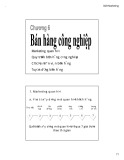

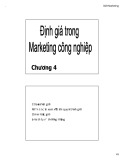
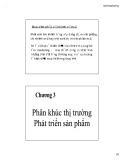
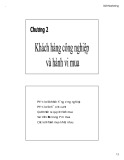
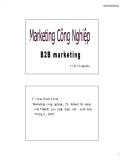
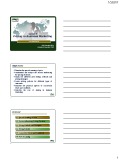
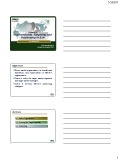
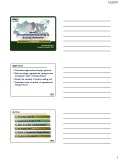


![Tối ưu hóa hiệu suất hệ thống: Bài thuyết trình [Chuẩn nhất]](https://cdn.tailieu.vn/images/document/thumbnail/2025/20251107/hiepdz2703@gmail.com/135x160/35941762488193.jpg)

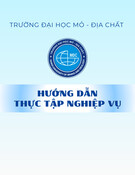


![Bài giảng Quản trị chất lượng trong công nghiệp thực phẩm [chuẩn nhất]](https://cdn.tailieu.vn/images/document/thumbnail/2025/20250805/vijiraiya/135x160/637_bai-giang-quan-tri-chat-luong-trong-cong-nghiep-thuc-pham.jpg)

![Đề cương bài giảng Kỹ năng hoạt động công nghiệp [mới nhất]](https://cdn.tailieu.vn/images/document/thumbnail/2025/20250715/kimphuong1001/135x160/76971752564028.jpg)


![Bài giảng Kỹ thuật điều độ trong sản xuất và dịch vụ [mới nhất]](https://cdn.tailieu.vn/images/document/thumbnail/2025/20250630/dcbaor/135x160/13121751251866.jpg)


